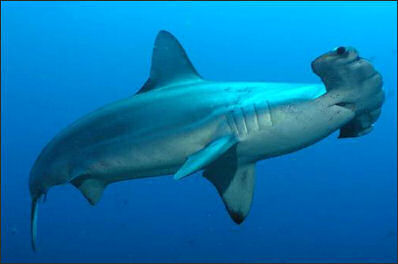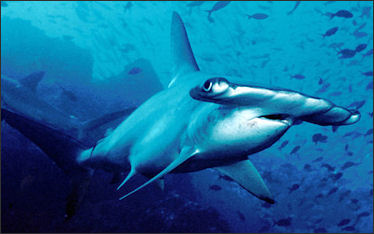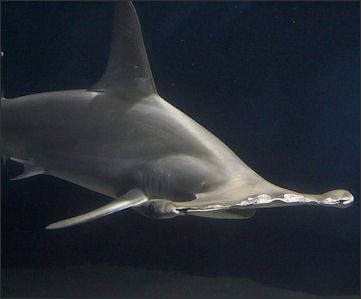Home | Category: Shark Species
HAMMERHEAD SHARKS

Hammerhead shark Hammerhead sharks are strong swimmers found mainly in the open ocean. They have distinctive heads with eyes at the end of winglike flaps. Although hammerhead usually average about 3.7 meters (12 feet) in length divers have spotted ones up to six meters (20 feet) long. Unlike other sharks they have small jaws. Those of most adults are only 30 centimeters wide. Their meat is considered too mealy and too pink for consumers. Some species migrate north to cooler waters in the summers. Hammerheads produce litters of 40 or more pups.
Hammerhead are regarded as timid and rarely attack humans. However, they have an unpredictable temperate. They usually flee at the sight of a diver or swimmer and divers regularly swim with large schools of them. Between 1876 and 2023, hammerheads were involved in 18 recorded unprovoked attacks. None of them were fatal. [Source: International Shark Attack Files, Florida Museum of Natural History, 2023]
One hammerhead caught off the Florida coast in 1906 weighed over 680 kilograms (1,500 pounds). In 2006, record 14-foot-6-inch, 1,280-pound hammerhead shark was caught in the Gulf of Mexico off Boca Grande by 36-year-old fishing guide Bucky Dennis, alone in a 23-foot skiff, after a six hour battle in which the shark dragged his boat 20 kilometers (12 miles). The shark was caught with a rod and line baited with a 25-pound stingray. Dennis told the New York Times, “The rod stayed in my hands the entire time. I was thinking, please don’t let it get off, please don’t let nothing happen.”
Related Articles: OPEN OCEAN SHARKS: BLUE SHARKS AND OCEANIC WHITETIP SHARKS ioa.factsanddetails.com; HAMMERHEAD SHARK SPECIES ioa.factsanddetails.com; HUMANS, SHARKS AND SHARK ATTACKS ioa.factsanddetails.com; SHARKS: CHARACTERISTICS, SENSES AND MOVEMENT ioa.factsanddetails.com ; SHARK BEHAVIOR: INTELLIGENCE, SLEEP AND WHERE THEY HANG OUT ioa.factsanddetails.com ; SHARK SEX: REPRODUCTION, DOUBLE PENISES, HYBRIDS AND VIRGIN BIRTH ioa.factsanddetails.com ; SHARK FEEDING: PREY, HUNTING TECHNIQUES AND FRENZIES ioa.factsanddetails.com
Websites and Resources: Shark Foundation shark.swiss ; International Shark Attack Files, Florida Museum of Natural History, University of Florida floridamuseum.ufl.edu/shark-attacks ; Animal Diversity Web (ADW) animaldiversity.org; National Oceanic and Atmospheric Administration (NOAA) noaa.gov; Fishbase fishbase.se ; Encyclopedia of Life eol.org ; Smithsonian Oceans Portal ocean.si.edu/ocean-life-ecosystems
Hammerhead Heads
 Hammerhead heads are one of the great oddities of the marine world and come in variety of shapes and sizes. When viewed from above the head of the winghead shark looks like letter “T” while the head of the bonnethead shark has a more modest “hammer,” less than five inches across. The origin of the head is unknown.
Hammerhead heads are one of the great oddities of the marine world and come in variety of shapes and sizes. When viewed from above the head of the winghead shark looks like letter “T” while the head of the bonnethead shark has a more modest “hammer,” less than five inches across. The origin of the head is unknown.
There are three theories that aim to explain the shape of hammerhead heads: 1) they improve sensory perception; 2) they are a hydrodynamic aid; and 3) they used as hammers to beat prey. Most scientists dismiss the last theory — a hammer with eyeballs at the end — as not being effective — yet the behavior has been observed and filmed. The second theory is based on the extraordinary maneuverability and quick turning ability of hammerheads and the fact that their design gives them extra lift as they swim. Not only that the hammer resembles the short wings found on some modern jet fighters and bombers.
Many scientists believe that hammerheads use their heads to sense and locate prey. Hammerhead heads have nostrils, electroreceptors and eyes at the end of each side of head. Wide-set eyes and nostrils provide keen periferal senses. Tiny electroreceptors visible on its snout help it pinpoint prey. Their eyes give them an extra wide field of vision.
Great hammerheads swim with their head swinging from side to side for enhance their search. When it smells food it swings it head from side to used to determine the location of the food. When the smell is equally strong on both sides, the sharks swims forward and is often one of the first predators to arrive on the scene.
Advantages of Hammerhead Heads
 Gavin Naylor wrote: Scientists think sharks with hammer-shaped heads have three main advantages. The first has to do with eyesight. If your eyes were pointing in two opposite directions, say, by your ears, it would give you a much wider field of vision. Each eye would see a different part of the world, so you’d have a better sense of what was around you. But it would be hard to tell how far away things are. [Source: Gavin Naylor, Director of Florida Program for Shark Research, University of Florida, The Conversation, July 25, 2022]
Gavin Naylor wrote: Scientists think sharks with hammer-shaped heads have three main advantages. The first has to do with eyesight. If your eyes were pointing in two opposite directions, say, by your ears, it would give you a much wider field of vision. Each eye would see a different part of the world, so you’d have a better sense of what was around you. But it would be hard to tell how far away things are. [Source: Gavin Naylor, Director of Florida Program for Shark Research, University of Florida, The Conversation, July 25, 2022]
To make up for that trade-off, hammerhead sharks have special sense organs, called ampullae of Lorenzini, scattered on the underside of their hammer. These porelike organs can detect electricity. The pores basically act like a metal detector, sensing and locating prey buried under sand on the ocean floor. Regular sharks have these sensory organs too, but hammerheads have more. The farther apart these sensory organs are on a hammerhead’s stretched-out head, the more accurate they are at pinpointing the location of food.
And finally, scientists think hammers help sharks make quicker turns while swimming. If you’ve ever walked in gusty wind with an umbrella or flown on an airplane, you know how powerful large surfaces can be in motion. If you’re a hammerhead shark, and your intended dinner swims by quickly, you can turn more rapidly to catch it than other fish can.
Hammerhead Evolution
Hammerhead sharks are one of the youngest shark groups. They evolved about 45 million years ago, according to the Natural History Museum in London. Gavin Naylor wrote: It would be nice if scientists like me could look at fossils and trace the development of hammerhead sharks over time. Unfortunately, fossils of hammerhead sharks are almost entirely of their teeth. That’s because the bodies of sharks do not have bones. Instead they’re made of cartilage, which is what your ears and nose are made of. Cartilage breaks down much more quickly than teeth or bones do, so it rarely gets fossilized. And tooth fossils don’t tell us anything about the evolution of hammerhead skulls. [Source: Gavin Naylor, Director of Florida Program for Shark Research, University of Florida, The Conversation, July 25, 2022]
 Scientists long assumed the first hammerhead sharks did not have much of a hammer but, over time, some slowly evolved bigger hammers. We thought the different hammerhead sharks living today were snapshots from different periods in the evolutionary process — with the small hammerheads being the oldest species on the family tree and the huge hammerheads being the newest ones on the scene.
Scientists long assumed the first hammerhead sharks did not have much of a hammer but, over time, some slowly evolved bigger hammers. We thought the different hammerhead sharks living today were snapshots from different periods in the evolutionary process — with the small hammerheads being the oldest species on the family tree and the huge hammerheads being the newest ones on the scene.
Since we don’t have fossils to look at, scientists like me have explored this idea using DNA. DNA is the genetic material found in cells that carries information about how a living thing will look and function. It can also be used to see how living things are related. We took DNA from eight of the nine hammerhead species and used it to look at the relationships among them. The results were not what we expected at all. The older species had the proportionally bigger hammers and the younger species had the smaller hammers.
When scientists think about evolution, we usually assume that living things change a little bit at a time, slowly fine-tuning themselves to take better advantage of their environment. This process is called natural selection. But that’s not always the way it works, as hammerhead evolution shows. Sometimes an animal can be born with a genetic defect that turns out to be really useful for its survival. So long as the abnormality is survivable and the animal is able to mate, that trait can be passed down. We think that’s exactly what happened with hammerhead sharks.
The hammerhead species that branched off the earliest is the winghead shark (E. blochii), which has one of the widest heads. Over time natural selection has actually shrunk the size of the hammer. It turns out the most recent hammerhead species is the bonnethead shark (S. tiburo), which has the smallest hammer of all.
Hammerhead Vision
It was long thought that hammerheads evolved their odd-shape heads with their eyes so far apart to enhance their vision. In 1942, Gordon Walls, a leading authority on sharks at the time, suggested the position of the sharks’ eyes prevented them from having binocular vision. In the late 2000s, hammerhead sharks were given eye tests and the results showed that sharks with wider heads have better binocular vision — better to track fast-moving prey like squid with far more accuracy than sharks with close-set eyes. [Source: Shanta Barley, New Scientist, November 27, 2009; Journal of Experimental Biology, vol 212, p 4010]
Jim Dawson wrote in National Geographic , “Why are hammerhead sharks’ eyes so widely separated on their bizarrely shaped heads? Whatever the evolutionary reason for the placement, scientists have debated whether it was to provide good vision. Florida Atlantic University marine biologist Michelle McComb has settled that vision question by studying three of the eight types of hammerheads. She found that hammerheads see not only directly ahead with binocular vision similar to that of humans; they also see up, down, and behind themselves simultaneously. “Their eyes are canted forward, and that is the key,” McComb says. [Source: National Geographic website, July 8, 2010]
Although hammerheads do have a particularly big blind spot in front of their widely spaced eyes, other senses compensate for this hole in their visual field. Sensors on the sharks’ heads help them detect electrical fields emitted by fish, and the placement of nostrils near their eyes could mean they use what McComb calls “enhanced stereo smell” to monitor the blind spot. “
Research shows that hammerheads have a 360-degree view of the world in the vertical plane, allowing them to simultaneously see prey above and below them. Shanta Barley wrote in New Scientist: McComb and colleagues “compared the visual fields of three species of hammerhead — the winghead, the bonnethead and the scalloped hammerhead — with those of two other species of shark. After implanting electrodes into the sharks’ eyes, the researchers moved a beam of light across them until the eyes no longer demonstrated electrical activity. This allowed them to measure each eye’s field of vision, which they summed to calculate each species’ “binocular overlap”. “To our surprise, we found that the degree of overlap increased as the head of the hammerhead species widened,” says McComb. The shark with the widest head, the winghead, had 48 degrees of binocular overlap; the others ranged from 10 to 32 degrees.
Hammerhead Feeding
Hammerheads feed mainly on squid and rays but eat a wide variety of fishes, including other sharks, octopus, and crustaceans. Stingrays are a favorite. The sharks catch them with their unique heads by pining them to the sea floor and immobilizing them by biting off their wings. Hammerheads are often found swimming along the bottom of the ocean, stalking their prey.
Bonnetheads feed on seagrass, which sometimes makes up as much as half their stomach contents. They may swallow it unintentionally, but they are able to partially digest it. At the time this behavior was discovered it was thought that bonnetheads were the only known omnivorous species of shark. Since then it has been found that whale sharks also are omnivorous).
Their eye separation gives hammerheads great binocular vision and depth perception — a bonus when pursuing fast-moving prey. The overlap that occurs where vision from their two eyes meet helps hammerheads to perceive depth as they hunt. Demian Chapman of the Institute for Ocean Conservation Science at Stony Brook University in New York, told National Geographic. “I’ve seen hammerheads chasing stingrays in the Bahamas. The rays are fast and can turn rapidly, so if the hammerhead is to catch one, it has to be able to keep its eye on the ball.” Hammerheads are able to avoid being stung by the poisonous spines of stingrays by pinning them down.
Hammerhead Schools
Hammerhead sharks sometimes amass in huge schools. Scientist have only lately discovered that they do this as part of an elaborate mating ritual in which large females fight for positions at the center of the school and males seek them out and do "torso thrust" dances to express their willingness too mate. If the a females accept the male they swim off alone to mate.
Schools of scalloped hammerheads, with 50 or 200 members, gather around Espiritu, a metal-rich seamount about 15 miles east of Baja California. The school are believed to be drawn in part by magnetic fields around the seamount.
It is believed that hammerhead sharks navigate using the earths magnetic fields and sense magnetic “roads” that radiate from underwater mountains. Young are sometimes observed migrating in large numbers. Some have suggested they form schools of protection from predators.
Endangered Hammerheads
Hammerheads have been seriously overfished in some places. Many have been snagged accidentally by long lines. Northern Atlantic hammerheads declined 89 percent between 1985 and 2000. The number of great, smooth and scalloped hammerhead sharks has dropped roughly 70 percent in the northwest Atlantic since 1981.
All large hammerhead sharks are classified as game fish. Their skin is often used for leather. Their meat is considered too mealy and too pink for consumers and they not widely commercially fished for meat but are for their fins. Many that are caught are bycatch victims. As of 2012, hammerheads made up approximately six percent of the identified fins entering the Hong Kong market. This works out to an estimated 1.3 million to 2.7 million hammerheads being taken annually for the global fin trade.
The number of Great hammerhead shark declined by 13 percent between 1981 and 2020. The number of smooth hammerhead sharks increased by 29 percent gain between 1973 and 2020. Smooth hammerheads have rebounded in areas with protections, such as the northwest Atlantic and Gulf of Mexico. [Source: Mónica Serrano and Sean McNaughton, National Geographic, July 15, 2021
Great hammerhead shark populations seem to be stable yet the International Union for Conservation of Nature (IUCN) Red List lists them as Endangered; They have no special status according to the Convention on the International Trade in Endangered Species (CITES).
Image Source: Wikimedia Commons, NOAA
Text Sources: Animal Diversity Web (ADW) animaldiversity.org; National Oceanic and Atmospheric Administration (NOAA) noaa.gov; Wikipedia, National Geographic, Live Science, BBC, Smithsonian, New York Times, Washington Post, Los Angeles Times, The New Yorker, Reuters, Associated Press, Lonely Planet Guides and various books and other publications.
Last Updated April 2023


